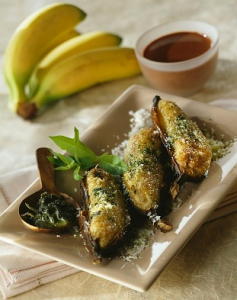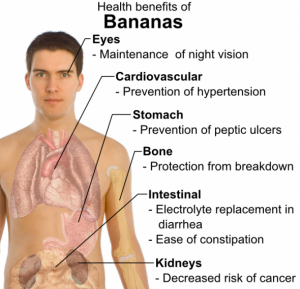 Bananas are healthy and nutritious fruits that are full of vitamins, minerals, and fiber. They can come in their own packaging, so they are easy to take on the road as part of a meal or snack. In addition, they taste great. Many people wonder how such a delicious fruit can be so good for you. You may ask how many calories are in a banana, and exactly how much fat does one banana contain? The exact figures vary depending on the size of the banana, but overall this is a low calorie, low fat fruit.
Bananas are healthy and nutritious fruits that are full of vitamins, minerals, and fiber. They can come in their own packaging, so they are easy to take on the road as part of a meal or snack. In addition, they taste great. Many people wonder how such a delicious fruit can be so good for you. You may ask how many calories are in a banana, and exactly how much fat does one banana contain? The exact figures vary depending on the size of the banana, but overall this is a low calorie, low fat fruit.
History of the Banana
Bananas were first cultivated in Southeast Asia, most likely in Papua New Guinea around 5000 BCE. They are native to this region, but over time slowly spread to nearly every continent. It is believed that bananas first spread to Africa and the Middle East, and then on to southern Europe. In the fifteenth century, Portuguese traders took the banana from Africa to the Americas, and the fruit has been thriving there ever since.
Banana Basics
This tasty yellow fruit grows best in tropical climates. It needs warm temperatures to grow and ripen. Frost or freezing temperatures will stop the growth of the banana tree, as will direct sunlight and searing temperatures. The best environment to produce healthy bunches of bananas is one that is warm and protected from direct sunlight and wind. There are over 300 species of bananas, and they come in many different shapes, sizes, and colors. The most common types of banana are the sweet yellow banana and the plantain.
Nutritional Information
Bananas are an excellent source of Vitamin B6, Vitamin C, Vitamin A, potassium, magnesium, manganese, sugars, and fiber. They are particularly low in fat and calories, although they do contain carbohydrates from starch and sugars. The proportions will vary depending on the size and type of the banana. Moreover, cooking or frying the banana will alter the amount of calories, fat, and sugars in the banana. The following is the nutritional information for a small raw yellow banana, between 6 and 7 inches long:
 For people wondering how many calories in a banana, a small sized banana will contain approximately 105 calories. The same banana will also contain:
For people wondering how many calories in a banana, a small sized banana will contain approximately 105 calories. The same banana will also contain:
- 0.33 grams of fat
- 1.09 grams of protein
- 2.6 grams of fiber
- 12.23 grams of sugar
- 22.84 grams of carbs
For every 100 grams of banana there are typically:
- 0.4 milligrams of Vitamin B6
- 8.7 milligrams of Vitamin C
- 358 milligrams of potassium
- 27 milligrams of magnesium
- 0.26 milligrams of iron
- 0.15 milligrams of zinc
As you can see, bananas are very healthy and contain plenty of vitamins, minerals, protein, and fiber. They also contain less calories and fat than many other snack foods.
Health Benefits of Bananas
 There are many positive health benefits that have been attributed to bananas. This fruit has been associated with a reduction in disease and health ailments. This is why many people recommend bananas for a range of health issues.
There are many positive health benefits that have been attributed to bananas. This fruit has been associated with a reduction in disease and health ailments. This is why many people recommend bananas for a range of health issues.
The high levels of potassium in bananas can help with a number of conditions. Potassium can help to lower high blood pressure and reduce the risk of strokes. It can also reduce stress, as the mineral can send much needed oxygen to the brain. This can also help to improve mental alertness and brain power.
Bananas also contain tryptophan, which your brain converts into serotonin. Serotonin production makes you more relaxed and happier. This can help with depression, Seasonal Affective Disorder (SAD), and Premenstrual Syndrome (PMS). The Vitamin B6 in bananas also contributes to reducing the side effects of these disorders.
Heart burn, hangovers, and ulcers can all be remedied with bananas. This is because bananas act as natural antacids. They also have soothing effects on the stomach, and can increase the level of blood sugars in the body.
How to Incorporate Bananas Into Your Diet
Now that you know how many calories are in a banana, the nutritional values, and the potential health benefits of this fruit, you can begin to incorporate this healthy food into your diet. Try to choose bananas that are slightly green or yellow. Bananas continue to ripen after they are cut off the stalk, so green bananas will turn yellow in time. Avoid buying bananas that are bruised, grey, or brown. This indicates that they are past their time.
Bananas are best eaten raw, as this retains the vitamins and minerals. They can be eaten straight out of the peel, cut up for a fruit salad, or sliced on top of granola and yoghurt. They can also be breaded and deep fried, thinly sliced and fried into chips, used in curries and soups, or blended and baked into cookies, muffins, and cakes.
For a healthy snack that is low in calories and fat, but packed full of vitamins, minerals and healthy sugars, bananas are an excellent choice. They have been linked to many positive health benefits, and they are easy to fit into any diet plan. Most importantly, bananas taste great, so they are a delicious way to meet your daily nutritional requirements.
{ 1 comment… read it below or add one }
Thank you for your great information about this wonderful fruit….the Beautiful Banana! It is sooo easy to pack and eat a banana for a quick snack or put into a blended fruit drink and receive many healthy benefits! It helps me tremendously when I eat bananas on a regular basis to prevent cramps in my toes. Great article!